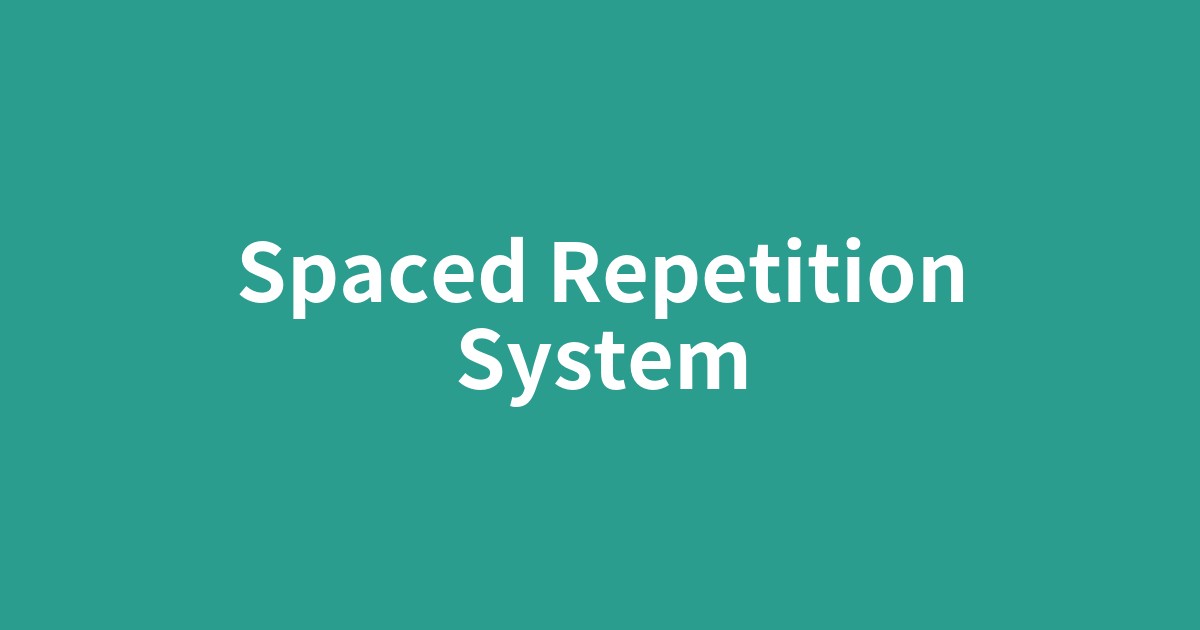このページは、歴史や文化の物語を楽しみながら、その文脈の中で重要な英単語を自然に学ぶための学習コンテンツです。各セクションの下にあるボタンで、いつでも日本語と英語を切り替えることができます。背景知識を日本語で学んだ後、英語の本文を読むことで、より深い理解と語彙力の向上を目指します。

忘れる直前のタイミングで復習するのが、最も効率的。忘却曲線に基づき、最適な復習interval(間隔)で知識を長期記憶に変える方法。
この記事で抑えるべきポイント
- ✓人間の脳は、情報を効率的に処理するために「忘れる」ようにできており、その忘却のペースはヘルマン・エビングハウスが発見した「忘却曲線」によって示されるという見方があります。
- ✓「間隔反復(Spaced Repetition)」とは、忘却曲線に基づき、「忘れかける最適なタイミング」で復習を繰り返すことで、記憶の定着(consolidation)を促す学習法です。
- ✓復習の間隔(interval)を徐々に広げていくことが重要であり、忘れかけた情報を努力して思い出す行為(retrieval)そのものが、脳の神経回路を強化すると考えられています。
- ✓この学習原理は、古典的なカードボックス法から現代の専用アプリ(SRS)まで、様々なツールに応用されており、言語学習に限らず普遍的な効果が期待できます。
間隔反復(Spaced Repetition)で効率的に記憶する
「一度覚えたはずなのに、すぐに忘れてしまう…」多くの学習者が抱えるこの悩みは、実は脳の正常な働きに起因するのかもしれません。人間の「忘れる仕組み」を逆手に取り、学習した知識を効率的に長期記憶へと変える科学的なアプローチ、「間隔反復」の世界へご案内します。
Efficient Memorization with Spaced Repetition
"I'm sure I memorized it, but I forget it so quickly..." This common frustration among many learners may actually stem from the normal functioning of the brain. Welcome to the world of Spaced Repetition, a scientific approach that turns our mechanism of forgetting to its advantage, efficiently converting learned knowledge into long-term memory.
「忘れる」は脳の防衛本能?—忘却曲線の発見
19世紀のドイツの心理学者、ヘルマン・エビングハウスは、自らを被験者として記憶に関する画期的な実験を行いました。無意味な音節を記憶し、それが時間と共にどれだけ失われるかを丹念に記録したのです。その結果、導き出されたのが有名な「忘却曲線(Forgetting Curve)」です。この曲線が示すのは、学習直後から記憶が急速に失われ、時間の経過とともにその忘却のペースが緩やかになるというパターンでした。これは、脳が膨大な情報を効率的に処理するため、重要でないと判断した情報を積極的に忘れるようにできている、という自然なプロセスを示唆しています。
Is Forgetting a Brain's Defense Mechanism? — The Discovery of the Forgetting Curve
In the 19th century, German psychologist Hermann Ebbinghaus conducted a groundbreaking experiment on memory, using himself as the subject. He meticulously recorded how much of a list of nonsense syllables he forgot over time. The result was the famous "Forgetting Curve." This curve shows a pattern where memory is lost rapidly immediately after learning, with the pace of forgetting slowing down over time. This suggests a natural process where the brain actively forgets information deemed unimportant to efficiently process vast amounts of data.
忘却への挑戦—間隔反復という発想
しかし、エビングハウスの発見は忘却のメカニズムだけではありませんでした。彼は同時に、「適切なタイミングでの復習が忘却を劇的に食い止める」という、さらに重要な事実も見出していたのです。これが、現代の学習法に大きな影響を与える「間隔反復(Spaced Repetition)」の基本原理(principle)となります。重要なのは、ただやみくもに繰り返すのではなく、復習と復習の間の時間、すなわち「間隔(interval)」を徐々に広げていくことです。一度復習して記憶が強化されると、次に忘れるまでの時間は長くなります。その伸びたタイミングに合わせて次の復習を行うことで、より効率的に記憶を維持できるのです。
Challenging Forgetting — The Idea of Spaced Repetition
However, Ebbinghaus's discoveries were not limited to the mechanics of forgetting. He also found another crucial fact: reviewing at the right time dramatically halts forgetting. This is the fundamental principle of Spaced Repetition, which has a significant impact on modern learning methods. The key is not to repeat mindlessly, but to gradually extend the time between reviews, known as the interval. Once a memory is strengthened by a review, it takes longer to forget. By scheduling the next review to coincide with this extended timing, memory can be maintained more efficiently.
なぜ「間隔」が記憶を強めるのか—想起と再固定化のメカニズム
では、なぜ間隔を空けた学習がこれほど有効なのでしょうか。その答えは、認知科学(Cognitive Science)の分野で研究が進んでいます。鍵となるのは、忘れかけた情報を努力して「思い出す」という行為そのものです。この「想起(retrieval)」と呼ばれるプロセスは、脳にとって負荷のかかる作業ですが、それこそが脳内の神経回路を再活性化させ、強化するトリガーとなります。この想起の努力を通じて、不安定だった記憶(memory)は、より強固でアクセスしやすい形に再構築されます。このプロセスこそが、記憶の「定着(consolidation)」であり、間隔反復はこの定着を最も効率的に促すための仕組みなのです。
Why Intervals Strengthen Memory — The Mechanism of Retrieval and Reconsolidation
So, why is spaced learning so effective? The answer is being explored in the field of Cognitive Science. The key is the very act of trying to "remember" information that is about to be forgotten. This process, called retrieval, is a demanding task for the brain, but it is precisely what reactivates and strengthens the neural circuits. Through this effort of retrieval, a fragile memory is rebuilt into a more robust and accessible form. This process is the consolidation of memory, and spaced repetition is the mechanism to promote this consolidation most efficiently.
現代に活かす間隔反復—実践のためのツールとヒント
この強力な学習原理は、日常生活でどのように実践できるのでしょうか。古典的な方法としては、覚えたカードと覚えていないカードを複数の箱で管理する「ライトナーシステム」が知られています。しかし現代では、テクノロジーがこのプロセスをさらに洗練させてくれました。AnkiやQuizletといった専用のアプリケーション(SRS: Spaced Repetition System)は、アルゴリズムに基づいて個人の忘却曲線を予測し、最適な復習スケジュールを自動で管理してくれます。こうしたツールを活用することで、学習の効率(efficiency)は飛躍的に向上し、語学の単語暗記から資格試験の知識習得まで、あらゆる場面でその効果を発揮します。
Applying Spaced Repetition Today — Tools and Tips for Practice
How can this powerful learning principle be put into practice in daily life? A classic method is the Leitner system, which manages flashcards in multiple boxes based on whether you've remembered them or not. But today, technology has refined this process even further. Dedicated applications (SRS: Spaced Repetition Systems) like Anki and Quizlet use algorithms to predict an individual's forgetting curve and automatically manage the optimal review schedule. By utilizing these tools, learning efficiency is dramatically improved, proving effective in various situations, from memorizing vocabulary for a new language to acquiring knowledge for professional certifications.
結論
間隔反復は、単なる暗記テクニックではありません。それは、私たちの脳が持つ「忘れる」という性質を否定するのではなく、それを理解し、賢く付き合うための普遍的な知恵と言えるでしょう。この学習原理を日々の学びに組み込むことで、私たちは限られた時間の中で最大の成果を上げ、語学から専門知識まで、あらゆる分野の学びをより深く、永続的なものへと変えていくことが可能になるのです。
Conclusion
Spaced repetition is more than just a memorization technique. It can be considered a universal wisdom for understanding and intelligently engaging with our brain's inherent nature of forgetting, rather than fighting against it. By incorporating this learning principle into our daily studies, we can achieve maximum results in a limited time, transforming all kinds of learning, from languages to specialized knowledge, into something deeper and more permanent.